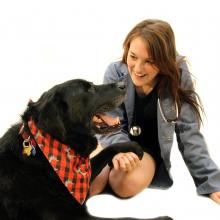Ask any vet student what the most satisfying procedure is, and 9 out of 10 will tell you it’s lancing an abscess. The only thing that can make this better is finding a foreign body inside! This week I was lucky enough to experience both of these!
We are in foxtail season here in Whitehorse. If you’re like me, and had no idea what a foxtail is; foxtails are seed clusters on certain grasses. These clusters have sharp barbs that allow them to embed into soil  as soon as they fall off the stalk. Unfortunately for dogs, these barbs can also end up embedded in their ears, nose, mouth, and skin. If the foxtails aren’t removed quickly, they can migrate deeper into the tissues and develop an abscess.
as soon as they fall off the stalk. Unfortunately for dogs, these barbs can also end up embedded in their ears, nose, mouth, and skin. If the foxtails aren’t removed quickly, they can migrate deeper into the tissues and develop an abscess.
There are a few signs to watch out for if your dog has been outside in an area where foxtails grow. Sudden sneezing, pawing at the face, nose bleeds, gagging, coughing, head shaking, squinting, tearing, and stiff gait may indicate that your dog has a foxtail. It’s important to seek veterinary attention as soon as any of these signs are noticed to avoid complicated infections. Your dog should be sedated to allow for a thorough exam and to reduce the risk of missed foxtails.
.jpg)
